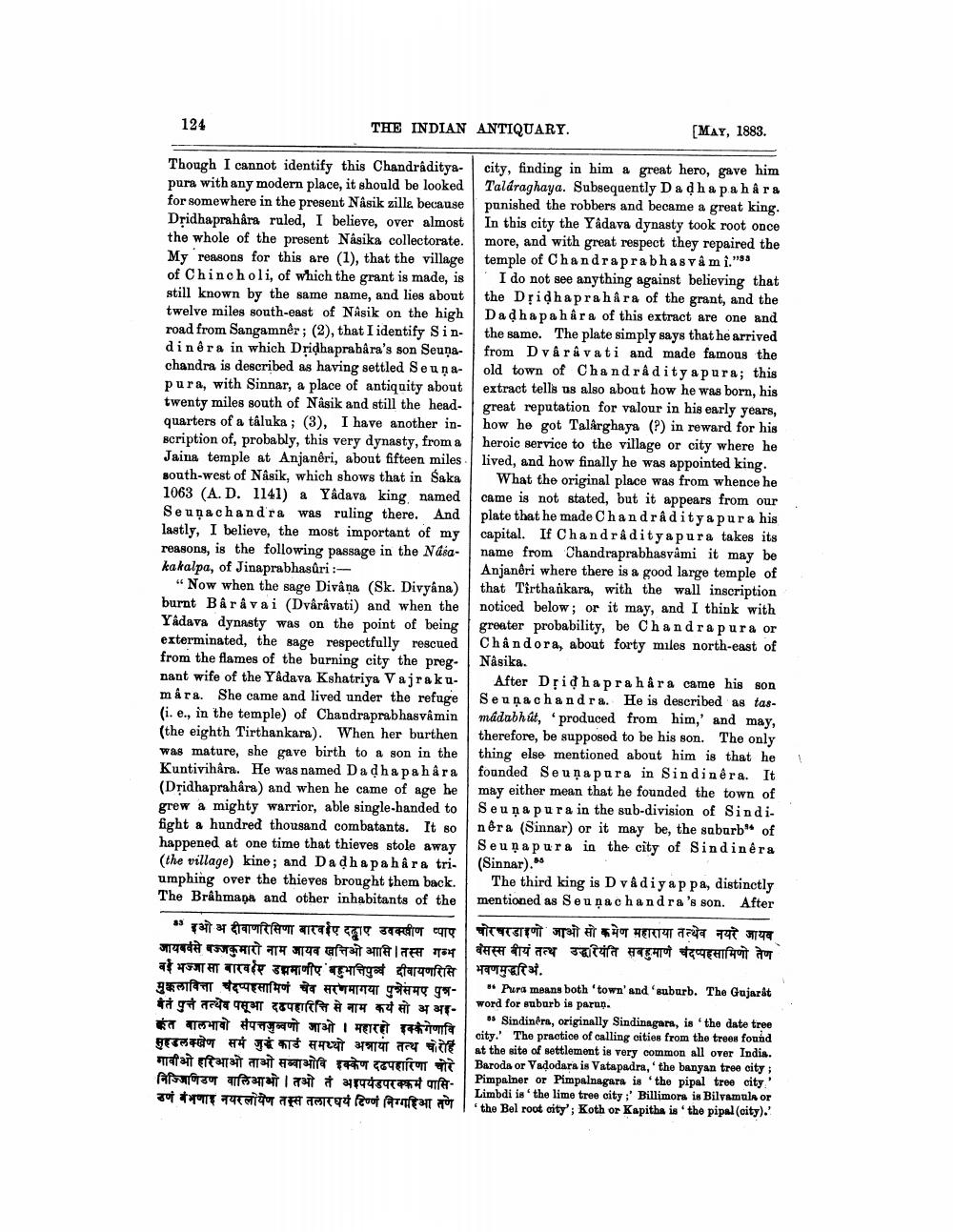________________
124
THE INDIAN ANTIQUARY.
[MAY, 1883.
Though I cannot identify this Chandraditya- pura with any modern place, it should be looked for somewhere in the present Násik zille because Dridhaprahâra ruled, I believe, over almost the whole of the present Násika collectorate. My reasons for this are (1), that the village of Chincholi, of which the grant is made, is still known by the same name, and lies about twelve miles south-east of Nasik on the high road from Sangamner; (2), that I identify Sin. dinêra in which Dridhaprabara's son Seuņachandra is described as having settled Seunapura, with Sinnar, a place of antiquity about twenty miles south of Nasik and still the head. quarters of a taluka ; (3), I have another inscription of, probably, this very dynasty, from a Jaina temple at Anjanëri, about fifteen miles south-west of Nâsik, which shows that in Saka 1063 (A. D. 1141) a Yadava king named Seuņachandra was ruling there. And lastly, I believe, the most important of my reasons, is the following passage in the Nasakakalpa, of Jinaprabhasûri :
"Now when the sage Divâna (Sk. Divyana) burnt Bå råvai (Dvârâvati) and when the Yadava dynasty was on the point of being exterminated, the sage respectfully rescued from the flames of the barning city the preg. nant wife of the Yadava Kshatriya Vajraku. mára. She came and lived under the refuge (i. e., in the temple) of Chandraprabhasvamin (the eighth Tirthankara). When her burthen was mature, she gave birth to a son in the Kuntivihåra. He was named Dadhapa håra (Dridhaprahara) and when he came of age he grew a mighty warrior, able single-handed to fight a hundred thousand combatants. It so happened at one time that thieves stole away (the village) kine; and Dad hapa hâra tri. umphing over the thieves brought them back. The Brâhmaga and other inhabitants of the
city, finding in him a great hero, gave him Taldraghaya. Subsequently Dad hapa hâr & punished the robbers and became a great king. In this city the Yadava dynasty took root once more, and with great respect they repaired the temple of Chandraprabhas vámi."
I do not see anything against believing that the Dridhapra håra of the grant, and the Dadhapa hâra of this extract are one and the same. The plate simply says that he arrived from Dvåra vati and made famous the old town of Chandrådity apura; this extract tells us also about how he was born, his great reputation for valour in his early years, how he got Talárghaya (?) in reward for his heroic service to the village or city where he lived, and how finally he was appointed king.
What the original place was from whence he came is not stated, but it appears from our plate that he made Chandråditya pura his capital. If Chandrådityapura takes its name from Chandraprabhasyami it may be Anjanôri where there is a good large temple of that Tirthankara, with the wall inscription noticed below; or it may, and I think with greater probability, be Chandrapura or Chandora, about forty miles north-east of Nâsika.
After Dșid hapra håra came his son Seunachandra. He is described as tasmadabhút, produced from him,' and may, therefore, be supposed to be his son. The only thing else mentioned about him is that he founded Seurapura in Sindinêra. It may either mean that he founded the town of Seu na para in the sub-division of Sindi. nêra (Sinnar) or it may be, the saburb of Seuņapura in the city of Sindinera (Sinnar).
The third king is D vadiyap pa, distinctly mentioned as Seuņa chandra's son. After
"भो अ दीवाणरिसिणा बारवईए दवाए उवक्षीण प्पाए | चोरचरडाणो जाओ सो कमेण महाराया तत्थेव नयरे जायव जायवर्वसे बजकुमारो नाम जायव खनिओ आसि | तस्स गम्भ वैसस्स बीयं तत्थ उद्धरियंति सबहुमाणे चंदप्पहसामिणो तेण वई मज्जा सा बारवईए उममाणीए बहुभानिपुवं दीवायणरिसि भवणमुद्धरिअं. मुक्कलाविता चंदप्पहसामिणं चैव सरणमागया पुसमए पुत्र
Pura means both 'town' and 'suburb. The Gujarat बैतं पुन तत्थेव पसूमा दढपहारित्ति से नाम कयै सो अ अइ.
word for suburb is parun.
" Sindinêra, originally Sindinagara, is the date tree कंत बालभावो संपत्तजुब्वणो जाओ । महारहो इक्कगेणावि |
city. The practice of calling cities from the trees found मुहडलक्जेण सम जुई कार्ड समथ्यो अनाया तत्थ चोरोहि at the site of settlement is very common all over Indis. गावीओ हरिआओ ताओ सब्बाओवि इक्केण दढपहारिणा चोरे Baroda or Vadodara is Vatapadra, the banyan tree city: निज्जिाणितण वालिआभो | तओ तं आपर्यडपरक्कम पासि
Pimpalner or Pimpalnagara is the pipal tree city
Limbdi is the lime tree city :' Billimora is Bilvamule or 301 TT THE ART et Foot Tatar the Bel root oity'; Koth or Kapitha is the pipal (city).'




